Squat Depth: How Deep Should You Squat? (PhD Explains)
Author:
Reviewed by:
(21 years of Oly Lifting experience)
Unlock your full potential by engaging with our experts and community! Have questions about your fitness journey or looking for expert advice on weightlifting techniques? Don’t hesitate — leave a comment below and Sergii Putsov will provide a personalized answer and insights to help you reach your goals.
Torokhtiy is reader-supported. Some links are affiliate links, and we may earn a commission at no extra cost to you. See our disclosure page for details.
Whether you’re new to weightlifting or not, at some point you’ll be trying squats. The problem is, as soon as you try you’ll get conflicting opinions about squat depth.
Some will tell you ass-to-grass, others that parallel squats are deep enough.
In short, you’re likely to be confused regarding how deep should you squat. We’re here to give you the answers.
Can You Improve Your Squat Depth? Yes, anyone can improve their squat depth. There are several techniques to help you do this. However, before you commit to getting your ass to the floor, you should understand the differences between squatting parallel or to the floor.
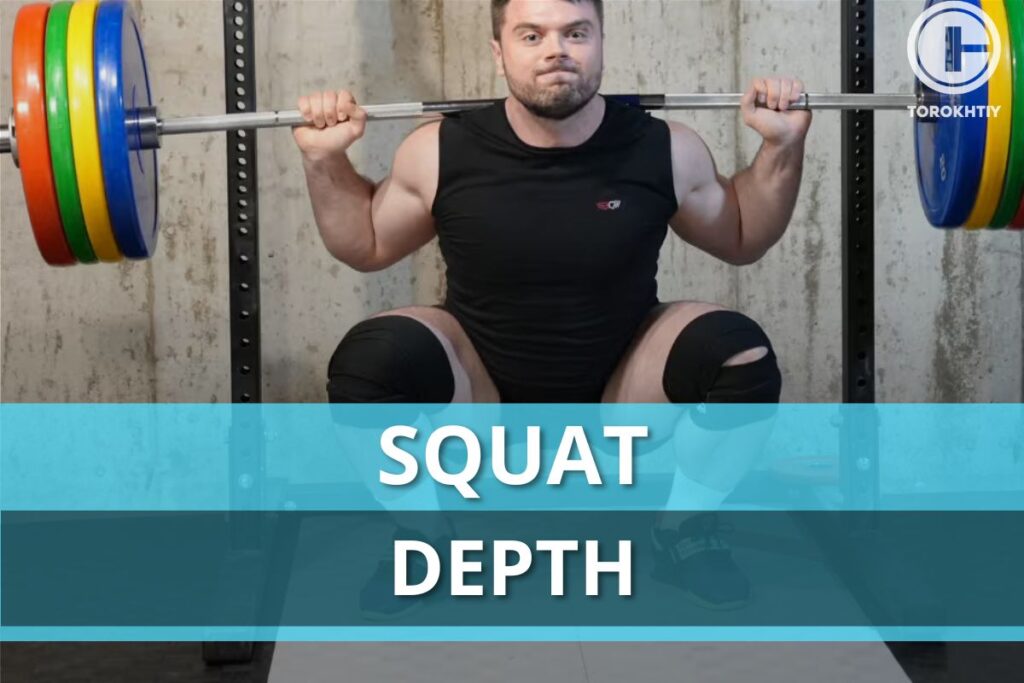
Does Squat Depth Matter?
If you’re reading this you’re trying to work out what your proper squat depth should be and whether it matters.
The truth is, that your ultimate squat depth is defined by several factors. Once you understand these factors you’ll understand how low to squat and be comfortable doing it, regardless of what anyone else says.
It’s worth noting that a squat is generally considered to be done when you reach or pass parallel. That’s the USAPL squat depth requirement.
How To Determine Your Ideal Squat Depth?
Let’s get straight into it. Here are the factors that will determine your proper squat depth and how low to squat.
1. Your Goal
Powerlifters, Olympic athletes, and almost anyone can benefit from deep squats. Research has shown that the deep squat can offer greater gains in functional strength and performance in comparison to the standard parallel squat.
However, for the older person, studies show that there is little change in the effect of training regardless of the squat depth chosen.
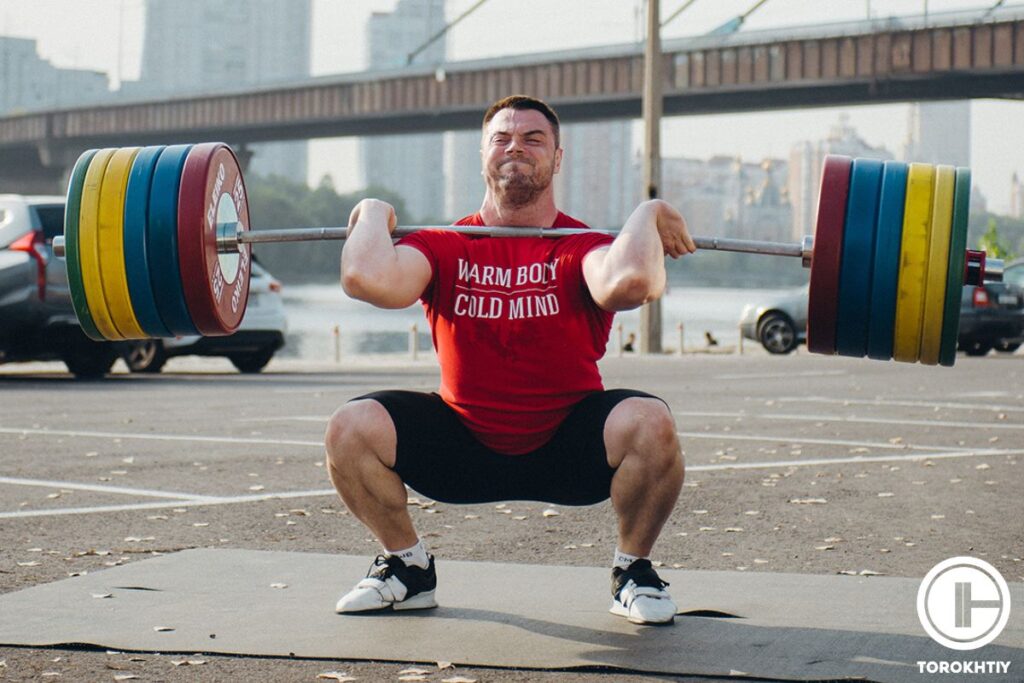
In fact, if you’re looking for powerlifting squat depth or to meet the USAPL squat depth, you don’t need to get your ass to grass, you just need to get your hip below the crease of your knee. That’s just past parallel.
If you’re simply looking to strengthen your muscles and find it difficult to go past parallel, then don’t force it and a possible injury.
2. Anatomy
You may not realize it but your anatomy could be what’s stopping you from getting your ass right to the floor.
People with deep hip sockets will not be able to bend their bodies as close to the ground as those with shallow hip sockets.
Research shows that the shape, size, and angle of your hip socket will have a major effect on your ability to squat low.
It’s not just your hips that will change your squat depth. The length of your upper body also plays an important part. The longer your body the harder it will be for you to squat low, keep a neutral spine, and keep the bar over your toes.
It’s a good idea to take a look at your body and your position while squatting, you may find you’re already at the correct squat depth for you.
3. Mobility
Your mobility level also makes a difference in correct squat depth. In order to get low in your squat you need to have good flexibility in your hips, knees, and ankles. Studies show there is a direct link between mobility in these areas and how deep you should squat.
The simplest way to visualize this is to think about your heels as you squat. They need to stay on the floor. If they come off your weight will move forward, pushing it over your knees and increasing the likelihood of injury. You can only squat as deep as your ankles will let you, once your feet start to lift you won’t be able to improve squat depth without first improving ankle mobility.
How To Improve Squat Depth?
If you have deep hip sockets you may struggle to get lower in your squat. The obvious solution will be to squat with your feet further apart.
However, in most cases, you can get lower, you just need to know how to improve squat depth.
1. Develop General Mobility
If you have poor ankle, hip, or knee mobility you’re going to need to improve it. Studies show the range of motion of the knee, ankle, and hips has a direct effect on squat depth.
That means doing dedicated exercises, such as making circles with your feet or even spelling the alphabet. Standing heel lifts are also a good option.
Hip mobility exercises include standing up and lifting one leg, bending it at the knee to get it to your chest. This also requires balance which works your core.
Heel pulls and hamstring stretches are two exercises which can help with knee mobility.
Follow us!

Free!
Get a 2-week Weightlifting Program as a bonus for the subscription to kickstart your training plan!

Free!
2. Correct Movement Pattern
If you want to know how to improve squat depth then spend some time evaluating your current squat movement. Your depth issue may simply be a result of poor form.
Start by filing yourself doing five unweighted squats, then continue filming as you do several weighted squats.
As you bend your knees don’t let them go over your toes, your back should remain neutral and you should avoid the butt wink.
If you find your form is incorrect, practice without weights until you get the form right. When you start using weights again, take it slow, monitoring your form. The right technique is more important than the amount of weight you’re lifting.
3. Squat According To Your Anatomy
We’ve already taken a look at anatomy. If you have deep hip sockets and can’t get your ass to grass, then try with a wider stance and don’t push it. You can still make good gains with a parallel squat.
Equally, if you have a long upper body, consider the angle of your body as you squat. Keeping your back neutral will keep it strong, reduce the likelihood of injury, and help you get lower.
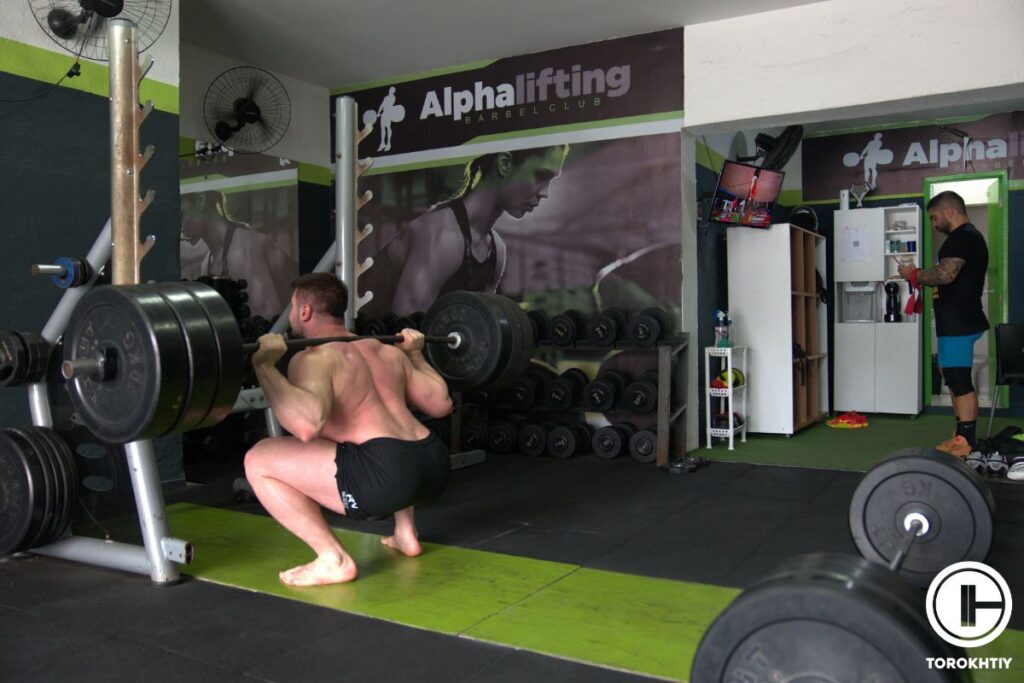
4. Perform Corrective Exercises
There are several corrective exercises you can do. Perhaps the most effective is foam rolling. Do this on your calves and thighs to massage the tissues, improve blood flow, and boost your flexibility.
You can also kneel with one knee on the floor, the other knee directly above your foot with the foot flat on the floor. Drive your knee forward, stopping as your heel starts to lift off the floor.
Another good corrective exercise is the goblet squat. However, place a weight under the heel of each shoe. It changes the angle of your feet and will improve your form.
You can also try the box squat. You effectively rest on the box for a second without relaxing your spine. It supports you as you work to get powerlifting squat depth.
5. Wearing Olympic Weightlifting Shoes
Another way to improve the depth of your squat is to use Olympic weightlifting shoes. These are shoes designed with a sturdy strong base, often with laces and straps to keep them secure. Most importantly, they have an inbuilt heel which adds between one and two inches to your heel height.
In effect, the shoe helps you perform a heel raise squat which changes your posture and enables you to get your ass closer to the floor. In effect, it will help you reach a competition depth squat, for most powerlifting competitions that’s simply your hip crease lower than your knee. Training to go deeper will make it easier to go low enough in any competition.
How To Squat Deep?
Now that you understand what’s causing your squatting issues and the corrective exercises you can do to help. You need to learn how to squat deep.
It’s simply a matter of form:
1. Starting Position
Your feet need to be either in line with your hips or slightly wider. If you have deep sockets you may favor a wider stance to help you improve your squat depth.
Your feet should be angled slightly, just 10-20°.
You should note the wider your stance the more you’ll need to angle your feet.
If you’re using weights, make sure you have a spotter present and the barbell is situated comfortably on your shoulders at the top of your back.
Now look straight in front of you. You should pick a spot to look at and keep looking at it while you squat.
You’re now ready to lower your body down, as though sitting in a chair. When you reach your desired depth, pause, before pushing yourself back to standing, make sure your knees are out and your chest is up.
2. Bracing And Breathing
Bracing as you squat means keeping your ribcage downward and your hips under your body. In effect, you’re preparing your body to support you, and your chosen weight, throughout the spot.
At the same time as you lower into the squat, take a deep breath. Concentrate on filling your lungs. Release this as you push back up from your squat.
3. Hip Hinge And Load Sequencing
Loading your squat correctly is important to ensure you maximize the weight and minimize the risk of injury.
What this means is that you hinge first at the hips. Push your butt back as you lean forward keeping your spine neutral. As soon as you start hinging at the hips, bend your knees, allowing you to sink into the squat.
Reverse this movement when you come back up.
4. Torque Force
The torque force is the amount of pressure exerted on a specific part of your body. With low-bar squats, the greatest torque will be on your hips. In contrast, high-bar squats will place the torque on your hips.
Understanding where the torque force is allows you to gauge when you have reached your current maximum load. Increasing this level of torque too quickly is likely to cause injury.
5. Record Your Lifts
Finally, record how many squats you have done, both reps and sets. You should also note how heavy your barbell is. This will help you to set goals and improve slowly.
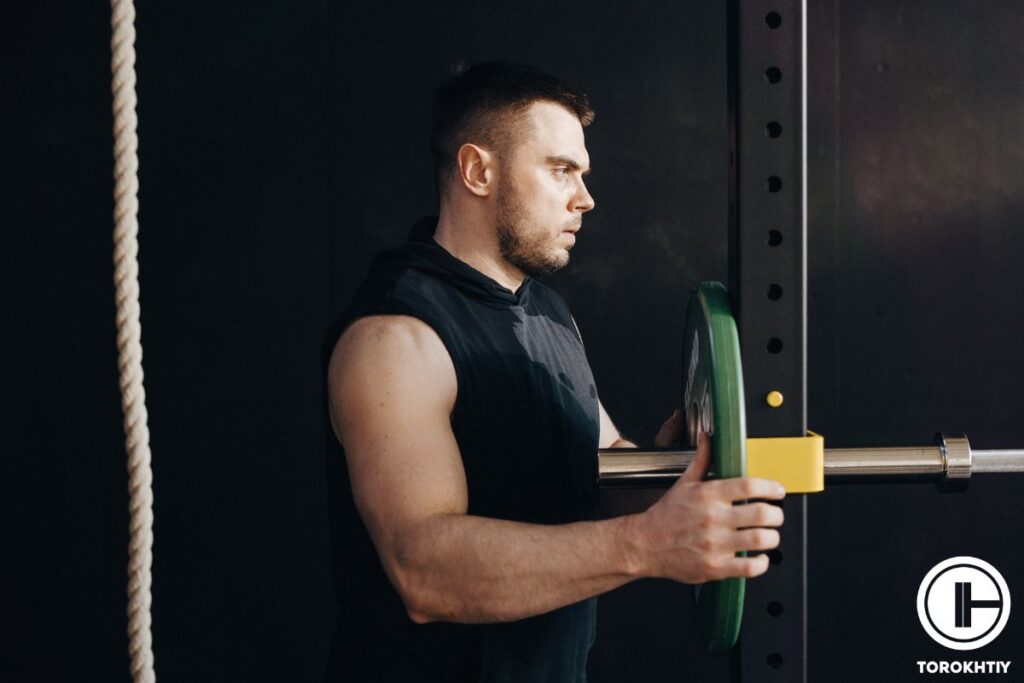
3 Common Mistakes To Avoid
If you’re looking at how to improve squat depth or wondering why can’t I squat low, then you’re likely to be pushing yourself to do better.
It’s essential that you’re aware of the most common squat mistakes, this will help you avoid making them.
1. Valgus Knee
This is surprisingly common when new to squatting. It simply means your knees move toward each other. It can happen at any time during the squat but is generally as you reach your lowest point.
Valgus knee isn’t likely to cause you immediate pain. However, if you continue to do this you are likely to develop knee pain in the future.
The reason your knees are moving together is that you’re lacking strength in your glutes. Targeting your glutes with strengthening exercises will help.
🔻GET A FREE PROGRAM DEMO: 12 Week Squat Program by Oleksiy Torokhtiy
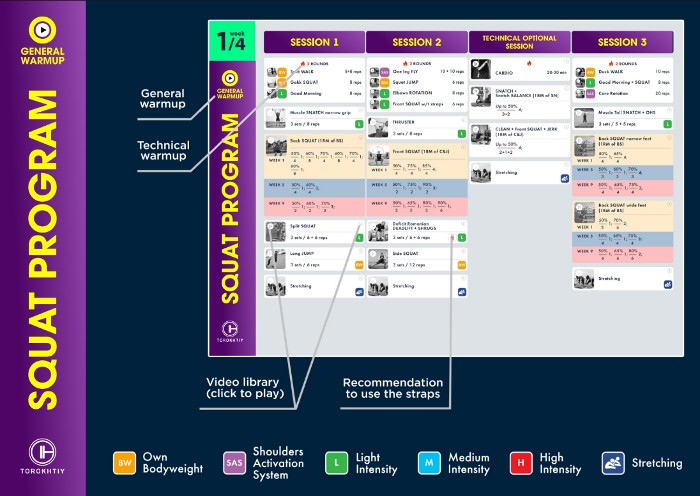
Do you want to double your squat strength? In just 12 weeks, you’ll be able to boost your squat results.
Enter your details and get a free demo (1 free week) of the squat program straight into your inbox.
2. Stripper Squats
The stripper squat is also known as the good morning squat. It refers to the movement as you come out of the squat and your hips rise faster than your spine. In effect, your chest moves closer to the ground.
It is usually a result of either fatigue or a weakness in your quads.
You’ll need to focus on pushing your hips up at the same time as your spine and making sure your spine stays in a neutral position.
3. Turtle Shell Squats
The turtle shell squat simply refers to rounding your back as you come up out of the squat. It is likely to cause back pain, your spine should remain in a neutral position throughout the squat.
In most cases, it’s a lack of stability in your core. The best remedy is to lighten your load and focus on your form while undertaking additional core-strengthening exercises.
It can also help to take a deep breath as you go into your squat and brace your stomach as though you’re about to be punched.
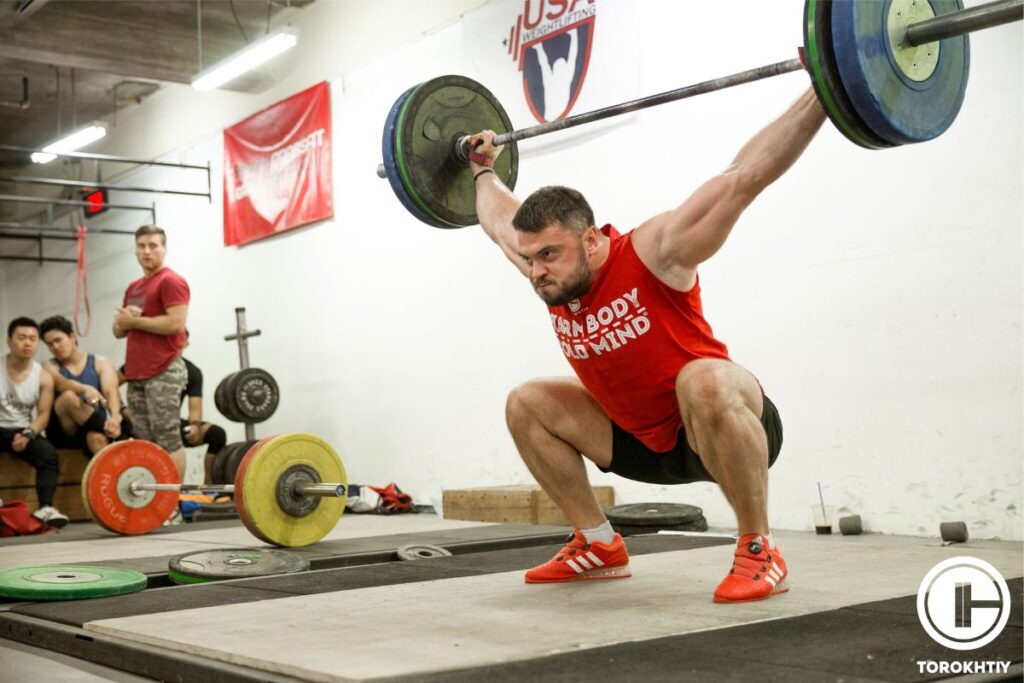
2 Benefits Of Deep Squatting
You should choose the squat depth you’re comfortable with. However, there are several benefits to deep squatting.
✅ Improved Flexibility
Weightlifters are often accused of having less flexibility due to their muscles constricting movement. However, deep squats will increase your flexibility as they’ll boost the mobility in your hips, ankles, and even your knees.
✅ More Explosive Power
Studies have shown that a deep squat is more effective at building glutes and inner thigh muscles. Gaining strength in these areas will help your explosive power. That’s the ability to shift heavy weights from the floor or to start a sprint.
That’s why deep squats are particularly beneficial for professional athletes.
2 Risks Of Deep Squatting
There are risks associated with squatting too low:
❌ Back Pain
If you squat too deep your spine is likely to flatten out. That means the natural arch will disappear. The exact depth of squat needed to do this is unique for everyone.
If you flatten your spine then you’ll place a lot of extra pressure on your spin, specifically your discs.
Doing this repetitively can cause bulging discs, tissue damage, and back pain.
❌ Knee Issues
Research suggests that deep squats can strengthen the muscles and tendons which support the knee. Regular squatting can even tighten the joints. In short, squatting isn’t likely to give you a knee issue.
However, if you already have bad knees due to an old injury, you may find squats aggravate it. This is particularly likely if you are using heavy weights or have poor form.
FAQ
Should You Squat Deeper Than 90?
You can squat past 90° but you don’t have to. It’s important to keep your spine neutral and stop your hips from tucking under. As soon as this starts to happen you should recognize that this is the current depth level of your squat.
Going past this invites injury.
Does Squat Depth Affect Muscle Growth?
Studies indicate deep squats do help muscle growth. They are particularly beneficial to your glutes and inner thigh muscles.
However, that doesn’t mean you should focus solely on squat depth. Consider your current limits and use the above tips to improve your squat depth safely.
Conclusion
You’re ready to improve your squat depth! Follow our tips and you’ll safely get lower than you ever have before. If you have any questions, just ask us.
If not, get started now and see how deep you can safely squat.
Also Read:
- What Muscles Do Squats Work? (Lifting Coach Explains)
- Squatting With Long Femurs: Tips For Lifters With Long Legs
- Squat and Deadlift Same Day: Right or Wrong?
- Shoulder Pain When Squatting: Causes & Prevention
- Safety Bar Squats: Form & Benefits Explained
- Lower Back Pain When Squatting: Causes & Fixes
- How Much Should I Be Able To Squat? Squat Standards Explained
- Do Squats Make Your Butt Bigger? (Improve The Result)
- Squat Stance: Understanding The Foundations
- Squat Sets And Reps: Everything You Need To Know
Referenses:
- Pallarés JG, Cava AM, Courel-Ibáñez J, González-Badillo JJ, Morán-Navarro R. Full squat produces greater neuromuscular and functional adaptations and lower pain than partial squats after prolonged resistance training. Eur J Sport Sci. 2020 Feb;20(1):115-124. doi: 10.1080/17461391.2019.1612952. Epub 2019 May 15. PMID: 31092132.
- Yoshiko, A., & Watanabe, K. (2021). Impact of home-based squat training with two-depths on lower limb muscle parameters and physical functional tests in older adults. Scientific Reports, 11. https://doi.org/10.1038/s41598-021-86030-7
- Zalawadia, A. et al. 2010. Study Of Femoral Neck Anteversion Of Adult Dry Femora In Gujarat Region. National Journal of Integrated Research in Medicine. Vol. 1, No. 3, pp. 7-11.
- Kim, H., Kwon, Y., Park, N., Jeon, C., & Weon, H. (2015). Lower Extremity Strength and the Range of Motion in Relation to Squat Depth. Journal of Human Kinetics, 45, 59-69. https://doi.org/10.1515/hukin-2015-0007
- Endo Y, Miura M, Sakamoto M. The relationship between the deep squat movement and the hip, knee and ankle range of motion and muscle strength. J Phys Ther Sci. 2020 Jun;32(6):391-394. doi: 10.1589/jpts.32.391. Epub 2020 Jun 2. PMID: 32581431; PMCID: PMC7276781.
Why Trust Us?
With over 20 years in Olympic weightlifting, strength training, nutrition coaching, and general fitness our team does its best to provide the audience with ultimate support and meet the needs and requirements of advanced athletes and professional lifters, as well as people who strive to open new opportunities and develop their physical capabilities with us.
By trusting the recommendations of our certified experts in coaching, nutrition, and sports training programming, as well as scientific consultants, and physiotherapists, we provide you with thorough, well-considered, and scientifically proven content. All the information given in the articles concerning workout programming, separate exercises, and athletic performance, in general, is based on verified data.
The product testing process is described in more detail here.
Author: Sergii Putsov
Head of Sport Science, PhD
Best Results: Snatch – 165 kg,
C&J – 200 kg
Sergii Putsov, Ph.D., is a former professional weightlifter and National team member, achieving multiple medals in the 94 kg weight category at national competitions. With a Master’s degree in “Olympic & Professional Sport Training” and a Sport Science Ph.D. from the International Olympic Academy, Greece, Sergii now leads as the Head of Sport Science. He specializes in designing training programs, writing insightful blog articles, providing live commentary at international weightlifting events, and conducting educational seminars worldwide alongside Olympic weightlifting expert Oleksiy Torokhtiy.
Reviewed by: Oleksiy Torokhtiy
Olympic Weightlifting Champion, PhD in Sport Science
Best Results: Snatch – 200 kg,
C&J – 240 kg
Oleksiy Torokhtiy is a professional athlete boasting 20 years of experience in Olympic weightlifting. With multiple European and World titles under his belt, he has showcased his prowess in two Olympic Games (Beijing 2008 and London 2012). Upon concluding his illustrious career, Oleksiy dedicated himself to coaching. By 2022, he had conducted over 200 weightlifting seminars worldwide. He is the visionary behind an international sportswear and accessories brand known for its motto, “Warm Body Cold Mind.” Additionally, he is an esteemed author and the creator of a series of training programs and eBooks.




Still have questions after reading our article? Unlock your full potential by engaging with our experts and community! Don’t hesitate — leave a comment below and Sergii Putsov will provide a personalized answer and insights to help you reach your goals.